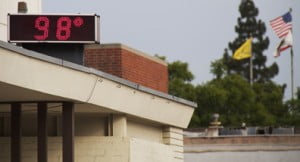
By Mary O’KEEFE
Six days into the fall season Los Angeles set a record-breaking temperature of 113 degrees Fahrenheit.
“That was an all time record for any day of the year since they began keeping record in 1877,” said Stuart Seto, weather specialist with the National Oceanic and Atmospheric Administration, Oxnard.Seto added that La Crescenta was 110 degrees Fahrenheit on Monday then dropped a little over 10 degrees on Tuesday.
“Wednesday you were at 88 degrees [Fahrenheit],” Seto said.
There were no reports of La Crescenta power outages with Southern California Edison, which serves the unincorporated areas of the Los Angeles portion of La Crescenta. Customers of Glendale Water and Power in Crescenta Valley found themselves without power, and more significantly without air conditioning, for about five hours on Monday.
“The outage affected 2,300 [Glendale Water and Power] customers,” said Rich Wells, spokesman for the city of Glendale. “We [did] hit a record usage on [Monday] of 343 megawatts.”
The outage was not due to the heat however but to a maintenance problem.
There were warnings from the National Weather Service that high temperatures were on the way and it appeared Crescenta Valley residents took heed.
“We didn’t have a significant spike [in calls],” said Station 82 Battalion Chief Mitch Brookhyser.
Because of the heat and the dry conditions the Los Angeles County Fire Department took steps to make certain the area was well protected.
“We augmented some staffing in the foothills with [extra] patrol units,” Brookhyser said. “During the heat wave no fires broke out.”
It was also quiet with the Glendale Fire Department as well.
“It was business as usual,” reported Capt. Stuart Stefani, Glendale fire.
The hot temperatures seemed more significant perhaps because of the cool summer.
“The mild summer was due to the cold ocean,” Seto said.
The sea breeze kept our temperatures down but an off shore flow blocked those cool winds from coming inland, he added.
Since spring Southern California has gone from an El Nino that typically brings more rain and is the warming of the ocean, to a La Nina, which is expected to carry through the early part of next year.
“That usually means less rain but temperatures can go either way,” Seto said.
Even though La Nino is less rain it does not mean that the foothills are out of flooding danger.
“Historically Glendale has had major floods three [to four] years after a brush fire,” said Glendale fire Capt. Stuart Stefani.
Less rain doesn’t mean any rain, Seto said. There could be significant storms that pass through.
The hot temperature of the past few days is another reminder of the dry vegetation that still surrounds Crescenta Valley. Although fire season is pretty much all year long in Southern California, traditionally the season began in October and November. During those months, after the dry summer, Santa Ana winds will blow and humidity is traditionally low.
“We have had some [fires] along the [Foothill] 210 freeway so far but we have kept them below ten acres,” Brookhyser said. “But there is no way we can predict what might happen in October and November.”
The Station Fire took care of a lot of the dry vegetation in the Angeles National Forest but fire danger is still a reality.
“We are not out of the woods,” Brookhyser added.
Both Brookhyser and Stefani remind residents to be alert and aware of their surroundings. If something seems suspicious or residents see smoke they should call local sheriff or police.

